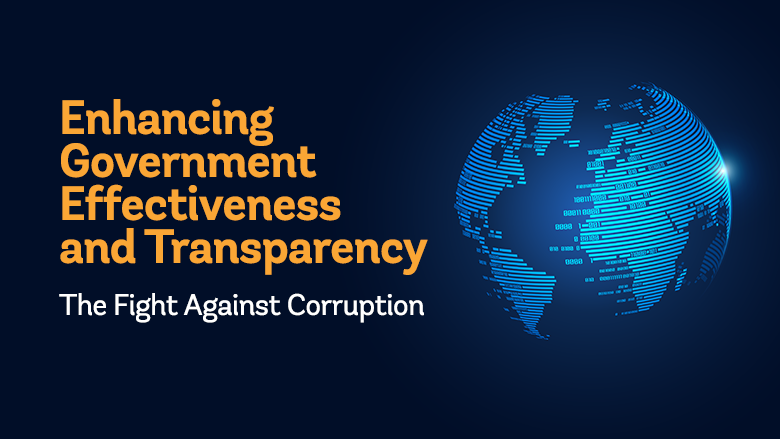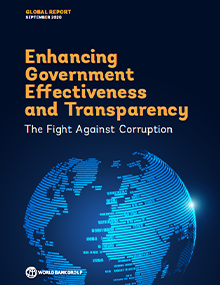

The report draws on the collective experts of staff across the World Bank to develop ways for enhancing the effectiveness of anti-corruption strategies in selected sectors and through targeted policy instruments. It covers issues, challenges and trends in five key thematic areas: Public Procurement; Public Infrastructure; State Owned Enterprises; Customs Administration; and Delivery of Services in selected sectors. The report also focuses on cross-cutting themes such as transparency, citizen engagement and Gov-tech; selected tools to build integrity; and the role and effectiveness of anticorruption agencies, tax and audit administrations, and justice systems. It features a country case study on Malaysia that traces the history of a country’s anti-corruption efforts over the last few decades.
**The report highlights that with the COVID-19 global pandemic, billions of dollars are being borrowed and spent by countries circumventing standard accountability procedures to manage the COVID-19 situation, leading to enhanced risk of corruption. To foster greater accountability, governments need to clearly articulate their actions, enforce rules, address violations, and remedy problems as quickly as possible in a transparent manner. The core tools of fiscal transparency, citizen engagement, and social accountability become ever more important.
Explore the Chapters
SETTING THE STAGE by James Anderson
PART I: CONFRONTING CORRUPTION IN SECTORS AND FUNCTIONS
Chapter 1: Public Procurement by Joel Turkewitz
- Case Study 1: Strengthening Competitive Procurement in Somalia by Fiona Davies, Carrie Farley and Geoff Handley
- Case Study 2: e-Procurement Reform in Bangladesh by Joel Turkewitz, Mihaly Fazekas and Zafrul Islam
- Case Study 3: Reforming Procurement and Political Party Financing in Chile by Serena Cocciolo and Joel Turkewitz
Chapter 2: Public Infrastructure by Ida Richter Gade and Ian Hawkesworth
- Case Study 4: Accountability in Infrastructure: The CoST Approach (Thailand, Ukraine, Honduras) by Alexandra Habershon, Soren Kirk Jensen and Marcela Rozo
- Case Study 5: Managing Public-Private Partnership (PPP) Renegotiation by David Bloomgarden
- Case Study 6: Open Contracting Reforms in Colombia by Ida Richter Gade, Nicolas Penagos and Sophie Brown
Chapter 3: State-Owned Enterprises by Sunita Kikeri and Ruxandra Burdescu
- Case Study 7: Enhancing SOE Accountability in Colombia by Ruxandra Burdescu, Ana Maria Palacio Jaramillo and Fanny Weiner
- Case Study 8: SOE Reforms in Brazil following “Lava Jato” by Kjetil Hansen and Ruxandra Burdescu
- Case Study 9: SOE Reforms in Angola by Kjetil Hansen, Soren Kirk Jensen and Ruxandra Burdescu
Chapter 4: Customs Administration by Odd-Helge Fjeldstad, Ernani Checcucci Filho and Gaël Raballand
- Case Study 10: Customs Reforms in Madagascar by Andreas Henrik Fiebelkorn
- Case Study 11: Customs Reforms in Afghanistan by Anna Custers
Chapter 5: Public Services: Land, Ports, Healthcare by Jana Kunicova
- Case Study 12: Land Administration Reforms in Rwanda by Thomas Shipley
- Case Study 13: Collective Action for Reforms in Nigeria Ports by Thomas Shipley
- Case Study 14: Reforms in the Health Sector in Ukraine by Sarah Steingrüber
PART II: KEY INSTRUMENTS FOR FIGHTING CORRUPTION
Chapter 6: Open and Inclusive Government by Stephen Davenport and Emily Kallaur
- Case Study 15: Boosting Accountability through Participatory Budgeting in Kenya by Blair Cameron
- Case Study 16: Enhancing Social Accountability in Ethiopia by Blair Cameron
Chapter 7: GovTech by Kai Kaiser
- Case Study 17: Digital Transformation in Andhra Pradesh, India by Pooja Churamani, Shashank Ojha and Kai Kaiser
Chapter 8: Asset and Interest Declarations by Dmytro Kotlyar and Laura Pop
- Case Study 18: Reform of Asset and Interest Disclosure in Ukraine by Dmytro Kotlyar and Laura Pop
- Case Study 19: Enhancing Effectiveness of Asset Declarations in Romania by Laura Pop, Laura Stefan and Silviu Popa
Chapter 9: Beneficial Ownership Transparency by Alexandra Habershon, Solvej Krause and Zosia Sztykowski
Chapter 10: Exchange and Collaboration with Tax Administrations by Prof. Jeffrey Owens, Joy Waruguru Ndubai and Siddhesh Rao
- Case Study 20: Inter-agency Collaboration to Detect Corruption by Prof. Jeffrey Owens, Joy Waruguru Ndubai and Siddhesh Rao
- Case Study 21: Sharing Evidence with Joint Prosecution Teams by Prof. Jeffrey Owens, Joy Waruguru Ndubai and Siddhesh Rao
PART III: ROLE OF INSTITUTIONS IN FIGHTING CORRUPTION
Chapter 11: Anti-Corruption Agencies by Alan Doig and Francesca Recanatini
Chapter 12: Supreme Audit Institutions by Seongjun Kim, Donald Mpande, Pooja Churamani, Manoj Jain and Carmen Loo
Chapter 13: Justice System by Klaus Decker
COUNTRY SPOTLIGHT: Malaysia's Approach to Fighting Corruption by Firoz Abdul Hamid and Jeevakumar Govindasamy